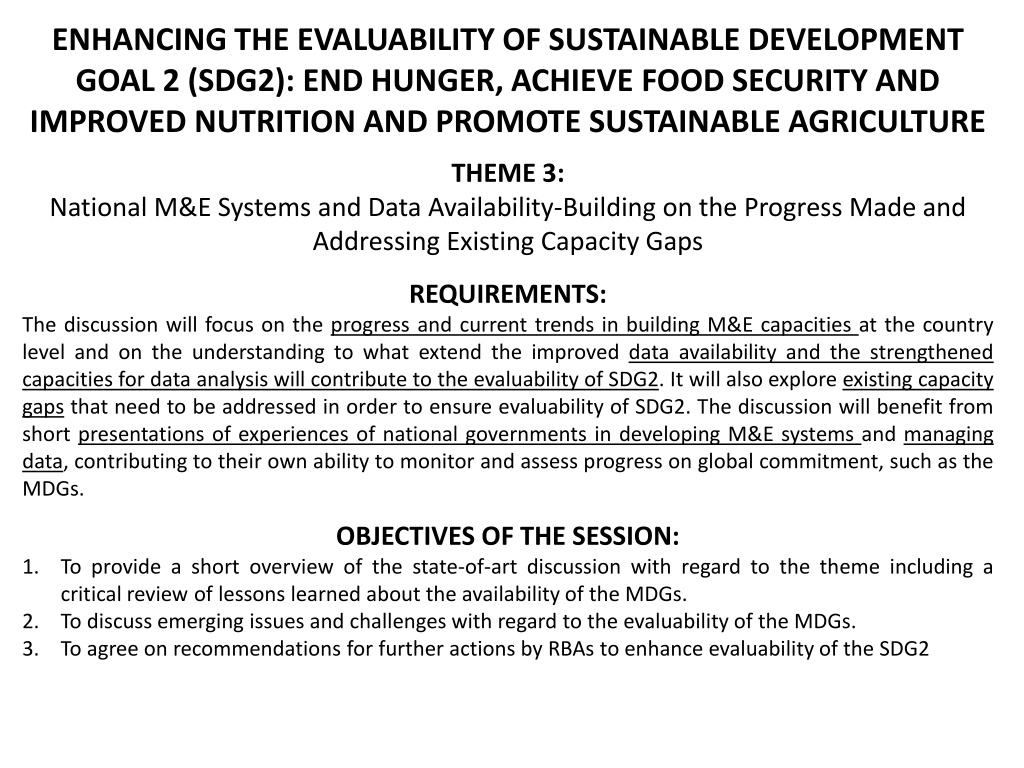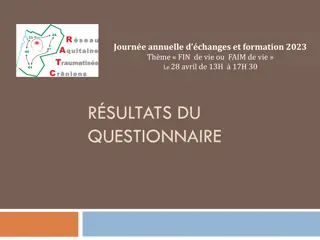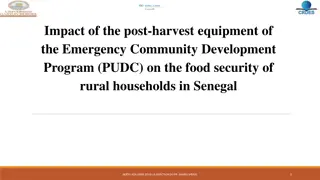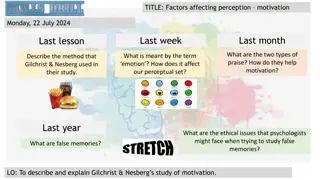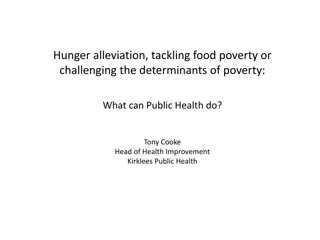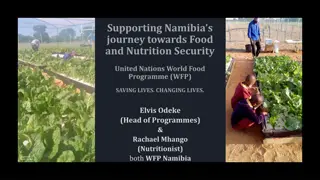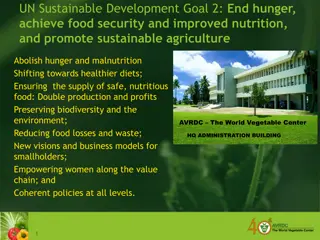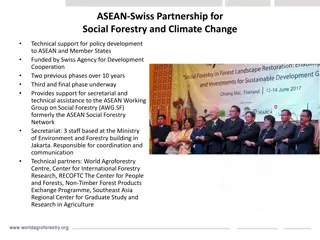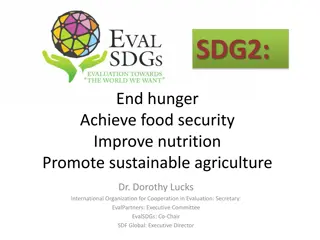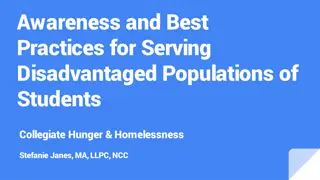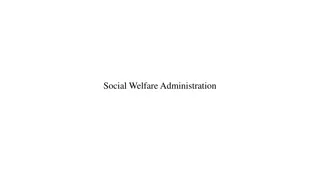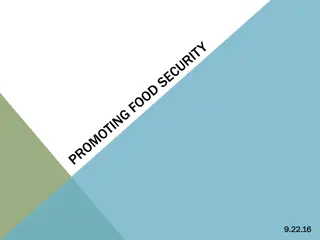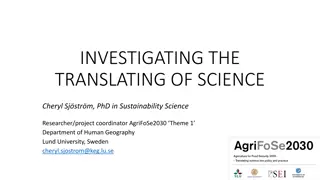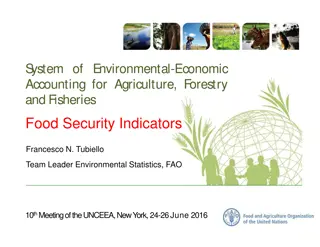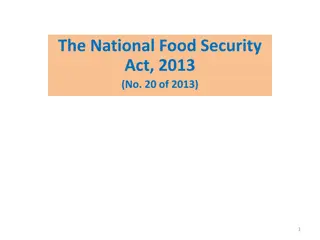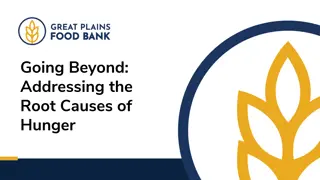Enhancing Evaluvability of Sustainable Development Goal 2: End Hunger and Achieve Food Security
This session explores building M&E capacities at the country level to enhance evaluability of SDG2. Discussions focus on progress, data availability, capacity gaps, and recommendations for action. Presentations share experiences from national governments on developing M&E systems. Malaysia's experience in developing M&E systems, managing data, and monitoring global commitments like SDGs is highlighted, emphasizing critical success factors for effective integration.
Download Presentation

Please find below an Image/Link to download the presentation.
The content on the website is provided AS IS for your information and personal use only. It may not be sold, licensed, or shared on other websites without obtaining consent from the author. Download presentation by click this link. If you encounter any issues during the download, it is possible that the publisher has removed the file from their server.
E N D
Presentation Transcript
ENHANCING THE EVALUABILITY OF SUSTAINABLE DEVELOPMENT GOAL 2 (SDG2): END HUNGER, ACHIEVE FOOD SECURITY AND IMPROVED NUTRITION AND PROMOTE SUSTAINABLE AGRICULTURE THEME 3: National M&E Systems and Data Availability-Building on the Progress Made and Addressing Existing Capacity Gaps REQUIREMENTS: The discussion will focus on the progress and current trends in building M&E capacities at the country level and on the understanding to what extend the improved data availability and the strengthened capacities for data analysis will contribute to the evaluability of SDG2. It will also explore existing capacity gaps that need to be addressed in order to ensure evaluability of SDG2. The discussion will benefit from short presentations of experiences of national governments in developing M&E systems and managing data, contributing to their own ability to monitor and assess progress on global commitment, such as the MDGs. OBJECTIVES OF THE SESSION: 1. To provide a short overview of the state-of-art discussion with regard to the theme including a critical review of lessons learned about the availability of the MDGs. To discuss emerging issues and challenges with regard to the evaluability of the MDGs. To agree on recommendations for further actions by RBAs to enhance evaluability of the SDG2 2. 3.
ENHANCING THE EVALUABILITY OF SUSTAINABLE DEVELOPMENT GOAL 2 (SDG2): END HUNGER, ACHIEVE FOOD SECURITY AND IMPROVED NUTRITION AND PROMOTE SUSTAINABLE AGRICULTURE THEME 3: National M&E Systems and Data Availability-Building on the Progress Made and Addressing Existing Capacity Gaps Proceedings: 1. Moderated discussion: Three discussants 2. Duration: Presentation and Q&A: 15-20 minutes 3. Proposed Focus of Malaysia s Presentation: a. Malaysia s experience in developing M&E systems and managing data; b. How Malaysia s M&E system monitor and assess progress on global commitment, such as the SDGs; c. Critical success factors in ensuring/making M&E systems workable Abstract Malaysia has embarked on transforming its focus from output to outcome initiated an outcome as early as 2005 with the introduction of Outcome-Based-Approach, Outcome-Based-Budgeting and Outcome Evaluation. The transformation not only enhance productivity and reduce potential susceptibility to wastage, it also ease the evaluating process at national and global level. The combination of visionary player, efficient tools and workable templates helps the smooth integration at vertical as well as horizontal, hence, creating a M&E system in Malaysia. However, there are several critical success factors need to be considered in ensuring the integrations are it at their best. 2
Malaysias Experience in Institutionalising and Executing the National M&E Systems 1. The Timely Transformation: Output to Outcome Orientation 2. The Three Essential Elements: Players, Tools and Framework 3. Linking Monitoring and Evaluation (M&E) to Sustainable Development Goal 2 (SDG2) 4. The Critical Success Factors in Addressing the Gaps 5. Questions & Answers 3
The Timely Transformation: Output to Outcome Orientation Outcome Evaluation (2005): Performance reporting and policy formulation Outcome-Based- Approach (OBA) (2010): National development planning based on results Planning for Outcome Results Reporting Budgeting for Outcome Outcome- Based- Budgeting (OBB) (2010): Preparing the resource requirements to drive the ministry results Outcome Evaluation (2005): Managing information for monitoring, evaluation and decision support system Monitoring & Evaluation 4
The Timely Transformation: Output to Outcome Orientation 2016 > Outcome-Based-Budgeting (OBB) Full implementation of OBB recommendations including full systems and institutions 2014 - 2015 Continuous data quality refinement Focus on monitoring & performance reporting Initiate Centre of Excellence & evaluation cycle to be operational Budget preparation for 2016 to be fully OBB compliant Integrated performance monitoring & reporting to be 2012-2013 OBB Policy Circular Roll out of OBB to all ministries (Parallel in 2012) Data validation & refinement 2010 - 2011 Developed OBB Conceptual Framework Awareness Programs Capacity Building (Trainers and RLs) Developed Initial Results Framework for all Ministries 5
The Timely Transformation: Output to Outcome Orientation Outcome Evaluation 2007> 2010-2012 REPORTING/ REVIEWING 2007 2006 ENHANCEMENT 2005 Assessment reports (aggregated according to ministries) sent to Public Service Department. ROLLING Outcome Evaluation Module was developed and incorporated into the Project Monitoring System. ENFORCEMENT DRAFTING Ministries/ Agencies/ Statutory Bodies embarked on the evaluation program by: Enforcement/ application to all head of division Designing the Guideline Performance Scorecard for all implementing agencies were issued and reported Training sessions conducted through conferences, workshops, bilateral with ministries/ agencies. Officiating the Development Program Evaluation Guideline Circular on August 24, 2005. Evaluating the completed projects to identify the outcome and impact. Performance Scorecard Evaluation results presented to stakeholders. Revising the Guideline Strategic collaboration Pilot testing on program evaluation and reporting. 6
The Timely Transformation: Output to Outcome Orientation Overall Framework Result Based Management (RBM) POLICY EVALUATION: NEED ANALYSIS/ CAUSE & EFFECT ETC FORMATIVE EVALUATION: MONITORING SUMMATIVE EVALUATION : OUTCOME/ IMPACT EVALUATION PLANNING IMPLEMENTATION EVALUATION POLICY INPUT ACTIVITIES OUPUT OUTCOME IMPACT RESULT CHAIN ICU JPM MOF EPU JPM ICU JPM EPU JPM AUDITOR GENERAL Feedback to Planning Strengths: Embedded capacity building within the framework Evaluation exists at all stages of project management (PIE) Structured two-ways mapping (top>bottom & bottom>up) Key players are independent bodies 7
The Three Essential Elements: Players, Tools and Framework PLANNING IMPLEMENTATION EVALUATION Framework RULES AND REGULATION Directive No 1 / 2010 Outcome Based Budgeting (OBB) EPU Circular No 1/2009 : Outcome Based Approach (OBA) SPA 3/2005 Outcome evaluation Impact evaluation Policy evaluation KPI Physical progress Expenditure KPI Intervention MONITORIN G ACTIVITY Budget screening KPI National Action Council National Action Working Committee National Action Council Outcome Evaluation Working Committee National Development Planning Council CENTRAL MONITORIN G PLATFORM Tools SPP II : Program/Project Submission Module SPP II : Performance Monitoring (Physical and financial) MANAGEME NT INFORMATIO N SYSTEM SPPII : Outcome Evaluation Module ICU MOF AUDITOR GENERAL PSD Players EPU MOF ICU EPU MOF ICU CENTRAL DRIVERS
Linking Monitoring and Evaluation (M&E) to SDG2 End hunger Food Security Improved nutrition Sustainable agriculture PROJECT & POLICY 9
Linking Monitoring and Evaluation (M&E) to SDG2 End hunger Food Security Improved nutrition Sustainable agriculture PROJECT & POLICY What we do? What we aim? Proof? Example of Activities Poverty eradication programs Fiscal Interventions Control of Supply Act 1961 Price Standardization Program Income generation programs Healthcare & related programs Education & related programs Housing & related programs Agriculture & related programs Research, Development & Commercialization (RDC) in agriculture Example of Goals/Outcomes Raising the income and wealth of B40 households Addressing the increasing cost of living Enhancing targeted support for undeserved communities (basic need and infra) Improving productivity and income of farmers, fishermen & smallholders Modernizing agriculture Example of proxy Indicators Incidence of poverty Primary school enrolments Rate of school drop-outs Consumable income House ownership Infant mortality rate SSL in agriculture Rate of commercialization Growth in agriculture sector 10
Example: Linkages in Poverty Eradication Program National Thrust Addressing Persistent Socioeconomic Inequalities NKRA Raising Living Standards of Low Income Households Raising the Income Generation Potential of Bottom 40 % Household Outcome National Program National Poverty Eradication Program Ministerial KRA Outcome KPI KKLW KWPKB KPWKM KPM Ministerial Programs Outcome KPI Social Safety Scheme for Disable and Lower Income Group Program for Students (Low Income Familiy) Integrated Economic Program for Urban Poor Integrated Development Program Program for Urban Housing Program for Urban Poor Program for Rural Housing Ministerial Activities Output Outcome KPI Assistance for Urban Poor Traders/ Entrepreneurs Assistance for Senior Citizens Integrated Agriculture Project Housing Rental Assistance Tuition Voucher Scheme Housing Project Training Allowance 11
Questions & Answers ahmadzaki@icu.gov.my nazaruddin.abu@icu.gov.my
